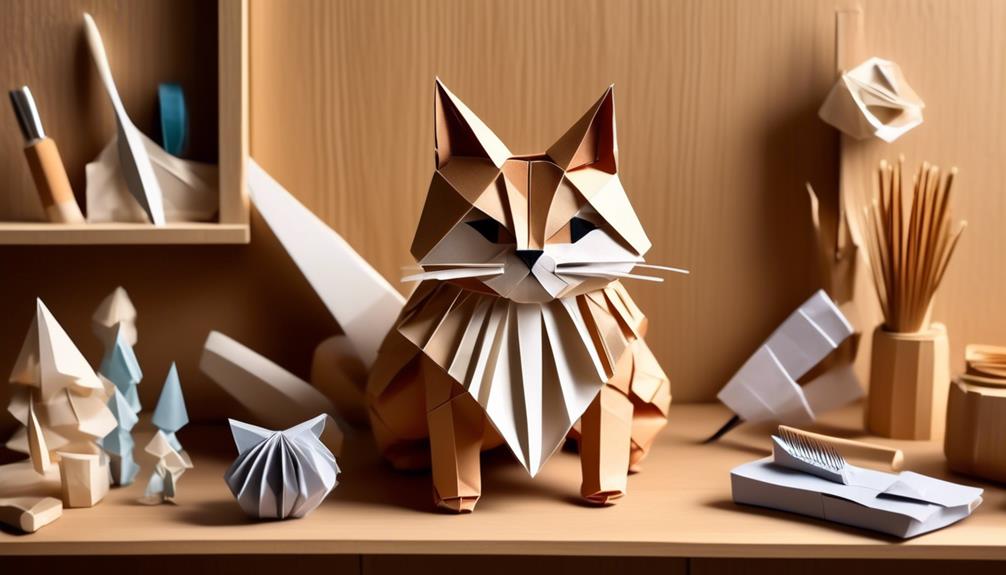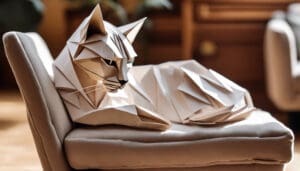As your cat enters their golden years, you’ll notice they might not be as diligent with their personal upkeep as they once were. It’s up to you to step in with a gentle hand and a bit of know-how to keep them comfortable and well-groomed.
You’ll want to create a serene sanctuary where both you and your senior cat can enjoy the grooming process together. Don’t worry; I’ll guide you through each step with kindness and expertise, from selecting the softest brush for their aging coat to understanding the signs that it’s time for a little trim.
Remember, patience is key, and while I can’t promise your fluffy friend will love every moment, I can assure you that the bond you’ll strengthen and the comfort you’ll provide are well worth the effort. Stick with me, and you’ll discover the fulfilling path to enhancing your older cat’s quality of life, one gentle stroke at a time.
Key Takeaways
- Observe your older cat’s behavior and physical condition to assess their grooming needs.
- Customize the grooming experience for your older cat’s comfort, considering any underlying skin conditions or mobility issues.
- Set up a cozy and quiet grooming area with all necessary tools within reach, using a soft mat or towel for added comfort.
- Use gentle brushing techniques and be cautious when trimming or bathing your older cat, ensuring their safety and calmness throughout the process.
Assessing Your Cat’s Needs
When grooming a senior cat, prioritize their unique needs with a gentle approach. Their fur is more delicate and their skin thinner, risking injury. Focus on more than just coat appearance; assess with compassion, noting any sensitivity or matting to tailor the grooming process for your cat’s comfort.
Consulting with your primary care veterinarian can provide valuable insights into the reasons why senior cats may require a different grooming approach. They might’ve underlying skin conditions or mobility issues that you’ll need to consider. Your vet can advise on safe grooming practices that cater to your cat’s health and well-being.
Preparing the Grooming Area
Before you begin grooming your beloved older cat, it’s important to set up a cozy spot that’s just for them. Make sure you’ve got all the brushes, combs, and nail clippers you’ll need at your fingertips to avoid any mid-grooming dashes.
And don’t forget to lay down a soft mat or towel to keep their paws comfy and secure—your cat deserves that extra bit of care.
Select Comfortable Location
To ensure your older cat feels secure and at ease, select a cozy spot for grooming, like a soft mat on a stable surface, where the quiet atmosphere can help them relax.
Before you start, here are a few essentials to consider:
- Brush your cat first: Gently brush your cat to remove loose fur, paying extra attention when brushing around sensitive areas.
- Comfort Measures: Place your cat on the chosen mat, keep the door closed to maintain a calm environment, and wrap a towel around them if needed for additional security.
- Soothing Environment: Stay calm and talk in a soothing calming voice to reassure them throughout the session.
Grooming your senior cat at a select comfortable location can transform care into a bonding experience that nurtures both their coat and your connection.
Gather Essential Tools
As you create a nurturing space for your older cat’s grooming session, start by gathering the essential tools. Place a gentle brush, a fine-toothed comb, specially designed nail clippers, and soft towels within easy reach on a stable, non-slip surface.
Select brushes and equipment that cater to your cat’s needs. The best types of brushes might include a rubber brush to gently remove loose fur or a pin brush to detangle longer coats. A metal comb can help with fine grooming details.
For bath time, have a special cat shampoo, a large plastic bin, and a detachable showerhead to rinse your cat thoroughly. If you’re planning to use a hairdryer, ensure it’s on a low, quiet setting.
Always seek advice on the best practices to keep your cat comfortable and safe during grooming.
Gentle Brushing Techniques
Gently stroke your cat’s coat from head to tail to familiarize yourself with their comfort levels before introducing the brush. This initial touch is a tender moment between you and your senior cat, setting the stage for a peaceful grooming session.
When you start to groom, remember these key points:
- Choose the Right Brush: Older cats often have more delicate skin, so select a brush that won’t irritate. A rubber brush can be an excellent choice for its gentle touch.
- Focus on Comfort: Pay close attention to areas where older cats get matted, like under the arms and behind the ears. Brush these areas with special care to avoid any discomfort.
- Regular Sessions: Consistency in grooming not only helps maintain their fur’s health but also strengthens the bond you share.
During brushing, use your tool with the same affection you’d show when petting. Let the brush glide smoothly through their fur, untangling any knots with kindness. If you encounter mats, don’t tug—older cats’ skin is more fragile. Instead, use your fingers to gently tease the tangles apart, maintaining a soothing presence.
Brushing your senior cats should be a loving routine, an act of care that speaks to your commitment to their well-being. With each stroke, you’re not only grooming—you’re cherishing the time you have together.
Safely Trimming Matted Fur
While regular brushing helps to prevent mats, when they do occur, it’s important to know how to safely trim your older cat’s matted fur with care and patience. If your cat has longer hair, you’re more likely to find mats that can’t be easily brushed out. When you do, hold the mat with one hand and gently loosen the mat with a comb. This will help brush out the tangles without pulling their skin.
For stubborn mats, use blunt-ended scissors to trim the fur. Lift the mat away from the skin and snip small sections at a time, being extra cautious not to nip your beloved pet. Remember, their skin is delicate, and areas can be sensitive around the hind legs.
Always ensure your older cat remains calm during the process; it’s not just about removing the mats, but also making sure they’re comfortable and stress-free.
To maintain a mat-free coat, regularly use a brush to detangle fur, and a rubber brush to collect loose hair. If you ever feel out of your depth, don’t hesitate to seek help from a professional groomer or veterinarian. Your gentle touch makes all the difference in their golden years.
Bathing Your Senior Cat
As your cat enters its golden years, bathing can become an important part of their care. You’ll want to gather all your supplies, including a cat-safe shampoo and a warm, cozy towel, before gently introducing your cat to the water.
Pre-Bath Preparation
Before you introduce your older cat to the water, make sure you’ve gathered all the necessary supplies for a stress-free bath experience. Your pre-bath preparation should include these steps:
- Gently Brush Your Cat: Depending on their coat, give them a thorough brushing. This helps remove loose fur and mats, making the bath more effective. Pay special attention when brushing around sensitive areas.
- Assemble Bathing Supplies: Have cat-safe shampoo, warm water, and a towel within reach. This keeps the process smooth without having to leave your cat unattended.
- Keep Your Cat Calm: Start by wetting your cat’s paws and slowly work your way up. Keep your senior cat’s head and face dry to avoid distress. Help distract your cat by giving affectionate reassurances throughout the bath.
Gentle Bathing Techniques
Begin by gently dampening your senior cat’s coat with warm water, ensuring a calm and soothing start to their bath time. Fill the bathtub with enough warm water to bathe your senior cat comfortably, but always keep their head and face dry to prevent distress.
Apply a cat-safe shampoo and use gentle bathing techniques, carefully massaging the soap into their fur from head to tail. As you work, try to gently loosen any dirt or debris, speaking softly to reassure your cat.
Once you’ve lathered their coat, let a showerhead rinse the soap away, making sure the soap is rinsed completely to avoid irritation. After the bath, wrap them in a dry towel and pat their coat gently, avoiding the head and face, until they’re cozy and dry.
Nail and Dental Care
Caring for your aging cat’s nails and teeth can enhance their comfort and well-being. As your cat matures, their needs evolve, and it’s important to keep in mind that an older cat has different sensitivities compared to their younger selves. Their limbs or joints may call for a gentler touch, so when you’re tending to their nails and dental care, do so with extra love and patience.
Here are a few tips to guide you:
- Trim their nails carefully: Use cat-specific clippers to avoid cutting into the quick, which is sensitive for older cats. If you’re unsure, a vet or professional groomer can assist and also show you how.
- Brush their teeth gently: Daily brushing with a cat toothbrush and feline toothpaste can prevent dental issues. Watch for problem areas and visit the vet if you suspect any issues.
- Monitor for changes: Cats often struggle and try to hide their discomfort. Regularly check their mouth and paws, and if you notice anything off, don’t hesitate to call your vet. They can diagnose and treat any issues before they become more serious.
Frequently Asked Questions
How Do You Groom a Senior Cat?
To groom your senior cat, speak softly, brush gently to avoid mats, use soft-bristled brushes, trim nails monthly, and keep regular vet check-ups for your cat’s health and happiness.
How Do You Clean an Elderly Cat?
Clean your elderly cat by softly wiping them with a wet cloth, making sure not to cause any discomfort due to their stiff joints.
How Do You Get Matted Hair off an Older Cat?
You’ll want to gently brush your older cat’s matted hair with a soft-bristled brush. If mats persist, consider a vet-approved detangling spray, but avoid cutting the mats to prevent hurting your beloved pet.
What Kind of Grooming Brush for Senior Cat?
For grooming your senior cat, choose a soft bristle or rubber curry brush. It’s gentle on their skin, easy to use, and prevents irritation, ensuring their coat remains healthy and clean.




